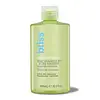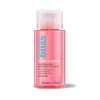What's inside
What's inside
 Key Ingredients
Key Ingredients

 Benefits
Benefits

 Concerns
Concerns

 Ingredients Side-by-side
Ingredients Side-by-side

Water
Skin ConditioningNiacinamide
SmoothingCamellia Sinensis Leaf Extract
AntimicrobialRosa Canina Fruit Extract
AstringentFomes Officinalis Extract
Skin ProtectingCucumis Sativus Fruit Extract
EmollientOryza Sativa Bran Extract
Skin ConditioningAvena Sativa Meal Extract
SoothingHamamelis Virginiana Leaf Water
AstringentSodium Hyaluronate
HumectantGlycerin
HumectantCopper Gluconate
Skin ConditioningMagnesium Aspartate
Skin ConditioningSorbitan Oleate Decylglucoside Crosspolymer
CleansingZinc Gluconate
Skin ConditioningGlycolipids
Skin ConditioningCaprylyl Glycol
EmollientPEG-40 Hydrogenated Castor Oil
EmulsifyingPolysorbate 20
EmulsifyingCaprylyl Glyceryl Ether
CleansingHexylene Glycol
EmulsifyingButylene Glycol
HumectantPropanediol
SolventSodium Phytate
Tetrasodium Glutamate Diacetate
Phenoxyethanol
PreservativeEthylhexylglycerin
Skin ConditioningCitric Acid
BufferingSodium Hydroxide
BufferingWater, Niacinamide, Camellia Sinensis Leaf Extract, Rosa Canina Fruit Extract, Fomes Officinalis Extract, Cucumis Sativus Fruit Extract, Oryza Sativa Bran Extract, Avena Sativa Meal Extract, Hamamelis Virginiana Leaf Water, Sodium Hyaluronate, Glycerin, Copper Gluconate, Magnesium Aspartate, Sorbitan Oleate Decylglucoside Crosspolymer, Zinc Gluconate, Glycolipids, Caprylyl Glycol, PEG-40 Hydrogenated Castor Oil, Polysorbate 20, Caprylyl Glyceryl Ether, Hexylene Glycol, Butylene Glycol, Propanediol, Sodium Phytate, Tetrasodium Glutamate Diacetate, Phenoxyethanol, Ethylhexylglycerin, Citric Acid, Sodium Hydroxide
Water
Skin ConditioningCitrullus Lanatus Fruit Extract
Skin ConditioningHamamelis Virginiana Leaf Extract
Skin ConditioningSalix Nigra Bark Extract
Skin ProtectingCopper Gluconate
Skin ConditioningMagnesium Aspartate
Skin ConditioningZinc Gluconate
Skin ConditioningSodium Hyaluronate
HumectantCucumis Sativus Fruit Extract
EmollientOryza Sativa Bran Extract
Skin ConditioningAvena Sativa Meal Extract
SoothingGlycerin
HumectantGlycolipids
Skin ConditioningCaprylyl Glycol
EmollientGlyceryl Caprylate
EmollientSorbitan Oleate Decylglucoside Crosspolymer
CleansingPolyglyceryl-5 Oleate
EmulsifyingCaprylyl/Capryl Glucoside
CleansingSodium Cocoyl Glutamate
CleansingPropanediol
SolventPhenoxyethanol
PreservativePotassium Sorbate
PreservativeSodium Benzoate
MaskingCitric Acid
BufferingParfum
MaskingWater, Citrullus Lanatus Fruit Extract, Hamamelis Virginiana Leaf Extract, Salix Nigra Bark Extract, Copper Gluconate, Magnesium Aspartate, Zinc Gluconate, Sodium Hyaluronate, Cucumis Sativus Fruit Extract, Oryza Sativa Bran Extract, Avena Sativa Meal Extract, Glycerin, Glycolipids, Caprylyl Glycol, Glyceryl Caprylate, Sorbitan Oleate Decylglucoside Crosspolymer, Polyglyceryl-5 Oleate, Caprylyl/Capryl Glucoside, Sodium Cocoyl Glutamate, Propanediol, Phenoxyethanol, Potassium Sorbate, Sodium Benzoate, Citric Acid, Parfum
 Reviews
Reviews

Ingredients Explained
These ingredients are found in both products.
Ingredients higher up in an ingredient list are typically present in a larger amount.
Avena Sativa Meal Extract is comes from the ground kernels of Avena sativa, or oats.
Oatmeal has skin soothing and hydrating properties.
Caprylyl Glycol is a humectant and emollient, meaning it attracts and preserves moisture.
It is a common ingredient in many products, especially those designed to hydrate skin. The primary benefits are retaining moisture, skin softening, and promoting a healthy skin barrier.
Though Caprylyl Glycol is an alcohol derived from fatty acids, it is not the kind that can dry out skin.
This ingredient is also used as a preservative to extend the life of products. It has slight antimicrobial properties.
Learn more about Caprylyl GlycolCitric Acid is an alpha hydroxy acid (AHA) naturally found in citrus fruits like oranges, lemons, and limes.
Like other AHAs, citric acid can exfoliate skin by breaking down the bonds that hold dead skin cells together. This helps reveal smoother and brighter skin underneath.
However, this exfoliating effect only happens at high concentrations (20%) which can be hard to find in cosmetic products.
Due to this, citric acid is usually included in small amounts as a pH adjuster. This helps keep products slightly more acidic and compatible with skin's natural pH.
In skincare formulas, citric acid can:
While it can provide some skin benefits, research shows lactic acid and glycolic acid are generally more effective and less irritating exfoliants.
Most citric acid used in skincare today is made by fermenting sugars (usually from molasses). This synthetic version is identical to the natural citrus form but easier to stabilize and use in formulations.
Read more about some other popular AHA's here:
Learn more about Citric AcidThis ingredient is a copper salt known for its wound healing properties.
Our bodies use copper to help stabilize our skin's collagen and elastin. Its also an essential for superoxide dismutase, an enzyme with strong antioxidant properties.
Copper has wound healing properties due to its role in creating new blood vessels and tissue repair.
Learn more about Copper GluconateThis extract comes from cucumber. Cucumbers are mostly made up of water (95%), and the other 5% is composed of: vitamin C, caffeic acid, fatty acids, amino acids, and other minerals.
Cucumbers have anti-inflammatory, barrier repair, and hydrating properties.
They contain shikimate dehydrigenase, an enzyme shown to help reduce inflammation and soothe the skin.
The amino acids found in cucumbers help nourish our skin's natural acid mantle (it's an important part of our skin barrier). This slightly acidic film acts as a barrier to protect us from bacteria, viruses, and other contaminants.
Unless you have an allergy to cucumbers, this is generally a non-irritating ingredient.
Fun fact: Cucumis Sativus is native to South Asia and can now be found on every continent.
Learn more about Cucumis Sativus Fruit ExtractGlycerin is already naturally found in your skin. It helps moisturize and protect your skin.
A study from 2016 found glycerin to be more effective as a humectant than AHAs and hyaluronic acid.
As a humectant, it helps the skin stay hydrated by pulling moisture to your skin. The low molecular weight of glycerin allows it to pull moisture into the deeper layers of your skin.
Hydrated skin improves your skin barrier; Your skin barrier helps protect against irritants and bacteria.
Glycerin has also been found to have antimicrobial and antiviral properties. Due to these properties, glycerin is often used in wound and burn treatments.
In cosmetics, glycerin is usually derived from plants such as soybean or palm. However, it can also be sourced from animals, such as tallow or animal fat.
This ingredient is organic, colorless, odorless, and non-toxic.
Glycerin is the name for this ingredient in American English. British English uses Glycerol/Glycerine.
Learn more about GlycerinGlycolipids are natural, sustainable biosurfactants. They are both surfactants (cleansing agents) and emollients.
Made from lipids and sugars, in-vitro studies show glycolipids are a gentle alternative to conventional surfactants. They also possess foaming properties to give cleaning products a nice texture.
One manufacturer study found their glycolipid also demonstrated sebum reduction and helped reduced oiliness after four weeks. This means it can also be great for scalp care.
Learn more about GlycolipidsWe don't have a description for Magnesium Aspartate yet.
Oryza Sativa Bran Extract comes from the outer layer of a rice kernel. It is a byproduct of milling rice, or the operation to produce a whole grain rice product.
This ingredient has moisturizing properties due to its components of polysaccharides and omega-3 fatty acids. It also contains calcium, selenium, phosphorus, iron, and zinc.
Oryza Sativa Bran Extract contains numerous antioxidants such as ferulic acid. Antioxidants help fight free-radical molecules. Free-radical molecules are capable of damaging our cells and other genetic material.
Learn more about Oryza Sativa Bran ExtractPhenoxyethanol is a preservative that has germicide, antimicrobial, and aromatic properties. Studies show that phenoxyethanol can prevent microbial growth. By itself, it has a scent that is similar to that of a rose.
It's often used in formulations along with Caprylyl Glycol to preserve the shelf life of products.
Propanediol is an all-star ingredient. It softens, hydrates, and smooths the skin.
It’s often used to:
Propanediol is not likely to cause sensitivity and considered safe to use. It is derived from corn or petroleum with a clear color and no scent.
Learn more about PropanediolSodium Hyaluronate is hyaluronic acid's salt form. It is commonly derived from the sodium salt of hyaluronic acid.
Like hyaluronic acid, it is great at holding water and acts as a humectant. This makes it a great skin hydrating ingredient.
Sodium Hyaluronate is naturally occurring in our bodies and is mostly found in eye fluid and joints.
These are some other common types of Hyaluronic Acid:
Learn more about Sodium HyaluronateSorbitan Oleate Decylglucoside Crosspolymer is also known as Poly Suga®Mulse D9 (We'll call is SODC for short).
SODC is a nonionic fragrance solubilizer. A solubilizer blends small amounts of oils into water-based formulas. It is especially good at solubilizing fragrances in water-only systems.
SODC does not contain PEGs. It is hydrophilic, meaning it has the tendency to mix with water.
In products, SODC acts as an emulsifer by blending waters and oils.
Learn more about Sorbitan Oleate Decylglucoside CrosspolymerWater. It's the most common cosmetic ingredient of all. You'll usually see it at the top of ingredient lists, meaning that it makes up the largest part of the product.
So why is it so popular? Water most often acts as a solvent - this means that it helps dissolve other ingredients into the formulation.
You'll also recognize water as that liquid we all need to stay alive. If you see this, drink a glass of water. Stay hydrated!
Learn more about WaterZinc gluconate has antibacterial and wound healing properties. It is particularly effective against fighting inflammatory acne.
This ingredient is the zinc salt of the PHA gluconic acid. PHAs are gentle cousins to AHAs.